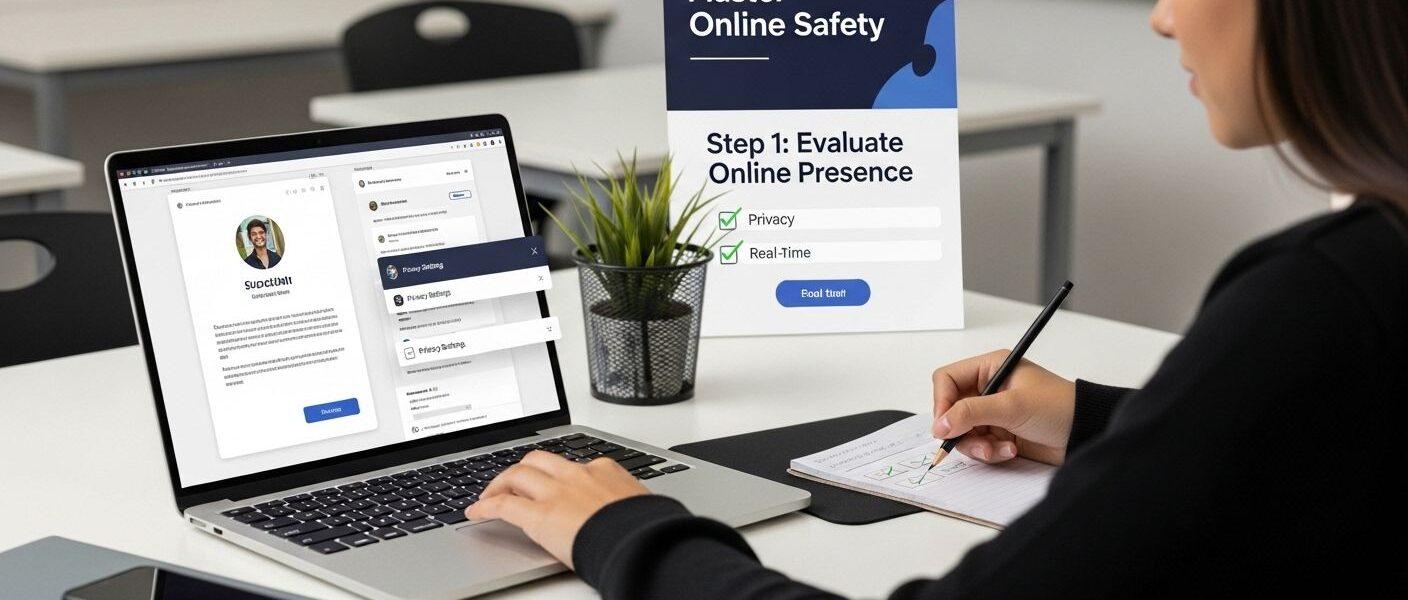
Nearly everyone leaves a digital trail online and for students this trail can reveal much more than they might realize. Nearly 80 percent of employers admit they review candidates’ social profiles before making hiring decisions and that’s just one audience. Most students think their accounts are harmless or too hidden to matter but the truth is your online presence is often public and permanent. Learning how to control it could mean the difference between opportunity and regret.
Quick Summary
| Key Point | Explanation |
|---|---|
| 1. Conduct a digital audit | Review all online profiles and posts to understand your visibility. Consider how this information may be perceived by others. |
| 2. Configure privacy settings strategically | Adjust settings on all accounts to limit access to your information. Use friends-only visibility and approve tags before they appear publicly. |
| 3. Use strong, unique passwords | Create complex passwords using a mix of characters. Use a password manager to keep them secure and unique across accounts. |
| 4. Stay vigilant against scams | Recognize tactics scammers use and verify communications through official channels. Be skeptical of unsolicited requests for personal information. |
| 5. Regularly review safety measures | Conduct quarterly assessments of your digital safety protocols. Stay updated on emerging threats and refine your strategies accordingly. |
Step 1: Evaluate Your Online Presence
Mastering online safety for students begins with a comprehensive understanding of your digital footprint. Your online presence is like an invisible resume that anyone can access, potentially revealing more about you than you realize. This critical first step involves carefully examining and managing the digital trail you create across various platforms.
Start with a Complete Digital Audit
Conducting a thorough digital audit requires systematically reviewing every online platform where you have an account. Open each social media profile, email service, and messaging application. Review your publicly visible information, including profile photos, biographical details, location tags, and past posts. Consider how these elements might be perceived by potential employers, academic institutions, or unknown viewers.
The Cybersecurity and Infrastructure Security Agency recommends being strategic about your digital visibility. Check privacy settings on each platform, ensuring you understand exactly who can view your content. Many students accidentally leave their profiles completely open, allowing strangers unrestricted access to personal information.
Implement Strategic Privacy Controls
Transform your online presence from potentially vulnerable to carefully curated. On social media platforms like Facebook, Instagram, and Twitter, adjust your settings to limit public visibility. Choose options that restrict profile access to confirmed friends or connections. Remove location tracking from your posts and photos, which can inadvertently reveal sensitive personal details.
Pay special attention to tagged photos and posts where others might share information about you. Many platforms allow you to review and approve tags before they appear publicly. Set up alerts that notify you when your name is used online, giving you immediate awareness of your digital representation.
Successful completion of this step means having a clear, controlled online presence where you consciously decide what information is publicly available.
Below is an overview table summarizing the six main steps for mastering student online safety, along with their core focus and intended outcome.
| Step | Core Focus | Intended Outcome |
|---|---|---|
| Step 1: Evaluate Online Presence | Auditing digital footprint | Increased awareness and control |
| Step 2: Configure Privacy Settings | Adjusting privacy on platforms | Limited unwanted access |
| Step 3: Utilize Strong Passwords | Creating/managing passwords | Enhanced account security |
| Step 4: Recognize and Avoid Scams | Spotting and deflecting scams | Reduced scam vulnerability |
| Step 5: Implement Safe Browsing Practices | Securing browser and browsing habits | Safer web usage |
| Step 6: Review and Upgrade Safety Plan | Ongoing review and learning | Adapted protection over time |
Step 2: Configure Privacy Settings
Configuring privacy settings is a critical defense mechanism in protecting your online safety as a student. This step transforms your digital platforms from potential vulnerability zones to secure personal spaces where you control information access and visibility.
Master Platform-Specific Privacy Controls
Each online platform requires a strategic approach to privacy settings. Start with social media accounts like Facebook, Instagram, and Twitter by accessing their privacy and security sections. Systematically review every privacy option, changing default settings to restrict who can view your profile, posts, and personal information. This means selecting friends only for post visibility, disabling public search discoveries, and preventing automatic tagging without your prior approval.
The National Cybersecurity Alliance recommends conducting a comprehensive review across all digital platforms. This includes messaging apps, email services, and cloud storage platforms. Pay special attention to location sharing features, which can unintentionally reveal your physical whereabouts to unknown audiences.
Implement Advanced Privacy Protections
Beyond basic settings, implement advanced privacy strategies. Use two-factor authentication on all accounts to create an additional security layer. Create separate email addresses for different purposes professional communications, personal interactions, and online registrations to minimize potential exposure. Regularly update passwords, ensuring they are complex and unique for each platform.
Consider using privacy-focused browser extensions that block tracking cookies and limit data collection. Virtual private networks (VPNs) can provide an extra shield by masking your digital location and encrypting internet traffic. These tools transform your online experience from potentially vulnerable to significantly protected.
Successful privacy configuration means having intentional, controlled digital interactions where you determine exactly what information is shared and with whom. Your goal is creating a digital environment that reflects your personal boundaries and protects your academic and professional reputation.
This table organizes key privacy and security tools mentioned in the guide, describing the resource and summarizing the primary purpose of each.
| Tool / Resource | Purpose |
|---|---|
| Password Manager | Store and generate strong, unique passwords for each account |
| Two-Factor Authentication | Adds extra verification beyond traditional passwords |
| Privacy Settings | Restrict who can view profiles, posts, and personal info |
| Antivirus/Anti-Phishing Software | Detects and blocks scams, phishing, and other online threats |
| VPN (Virtual Private Network) | Encrypts internet traffic, masks digital location |
| Privacy Browser Extensions | Block tracking cookies, limit data collection |
| Alerts/Notifications | Notifies you about tags or mentions of your name online |
Step 3: Utilize Strong Passwords
Strong passwords serve as the digital locks protecting your personal information from unauthorized access. In an era where cyber threats continuously evolved, creating robust password strategies becomes your first line of defense against potential security breaches.
Craft Unbreakable Password Foundations
Designing strong passwords requires more than simple combinations. Avoid using personal information like birthdays, names, or common words that can be easily guessed. Instead, create complex passphrases that blend seemingly unrelated words with numbers and symbols. Consider using a memorable sentence or phrase and transforming it into a cryptic code that only you can understand.
The Cybersecurity and Infrastructure Security Agency recommends creating passwords at least 16 characters long. Think of your passphrase as a unique personal encryption. For example, transform “I love studying computer science” into something like “1L0v3St*dyingC0mput3rSc!ence” combining uppercase, lowercase, numbers, and special characters.
Implement Comprehensive Password Management
Managing multiple complex passwords requires strategic approaches. Password managers become invaluable tools in this process, securely storing and generating unique passwords for each account. These applications eliminate the need to memorize dozens of complicated codes while ensuring each digital entry point remains uniquely protected.
Implement a systematic password rotation strategy. Change critical account passwords every three to four months, particularly for email, banking, and academic platforms. Create different passwords for each account to prevent a single breach from compromising multiple systems. Use two-factor authentication whenever possible, adding an extra layer of security beyond the password itself.
Successful password management means developing a personalized system where your digital credentials remain strong, unique, and continuously updated. Your goal is creating an impenetrable password strategy that protects your online identity across all digital platforms.

Step 4: Recognize and Avoid Scams
Online scams represent a sophisticated digital minefield that targets students with increasing complexity and psychological manipulation. Understanding how to identify and deflect these threats becomes crucial in maintaining your digital safety and protecting your personal information from malicious actors.
Understand the Scammer’s Psychological Playbook
Scammers exploit human emotions like fear, excitement, and urgency to bypass rational thinking. Be extremely cautious of communications that create an immediate sense of panic or promise unrealistic rewards. Fake emails claiming your account will be suspended, messages about unexpected winnings, or urgent requests for personal information are classic manipulation tactics designed to trigger impulsive responses.
The University of Iowa’s Information Technology Services emphasizes the importance of verifying unexpected communications through official channels. When receiving any digital communication requesting action, independently contact the purported organization using official contact information from their verified website, not through links or phone numbers provided in the suspicious message.
Develop a Critical Verification Mindset
Creating a robust defense against scams requires developing a skeptical approach to digital interactions. Scrutinize every unsolicited communication with a critical eye. Check email sender addresses carefully, looking for subtle misspellings or unusual domains that might indicate fraudulent origins. Legitimate organizations will never request sensitive information like social security numbers, banking details, or login credentials through informal digital channels.
Install reputable antivirus software that includes email and web scanning capabilities. These tools can help detect potential phishing attempts and malicious websites before you inadvertently engage with them. Be particularly vigilant about links in emails, messages, or social media posts, always hovering to preview the actual destination before clicking.
Successful scam prevention means maintaining constant digital awareness, trusting your instincts, and understanding that legitimate organizations prioritize your security. Your goal is transforming yourself from a potential victim into a confident, informed digital citizen who can navigate online spaces with strategic caution.
Step 5: Implement Safe Browsing Practices
Safe browsing practices are your digital shield against numerous online threats that can potentially exploit your personal information and device security. This step transforms your internet navigation from a vulnerable experience to a strategic, protected interaction with the digital world.
Master Browser Security Configuration
Your web browser serves as the primary gateway to the internet, making its configuration critical for online safety. Regularly update your browser to ensure you have the latest security patches and protection mechanisms. Modern browsers offer built-in security features like tracking protection, pop-up blockers, and warnings about potentially dangerous websites. Activate these features and customize them to provide maximum protection.
The Cybersecurity and Infrastructure Security Agency recommends carefully managing browser extensions. Only install reputable extensions from verified sources, and periodically review and remove unnecessary add-ons that might create potential security vulnerabilities. These small digital tools can sometimes access significant amounts of your browsing data, so treat them with the same caution you would any other digital access point.
Develop Advanced Browsing Strategies
Beyond basic configuration, develop a proactive approach to online navigation. Always verify website security by checking for the padlock icon and “https” in the URL, which indicates an encrypted connection. Avoid conducting sensitive transactions like banking or entering personal information on public Wi-Fi networks, which are notoriously vulnerable to intercepting digital communications.
Consider using virtual private networks (VPNs) to encrypt your internet traffic and mask your digital location. These tools add an extra layer of anonymity and protection, especially when accessing the internet through potentially unsecured networks. Install reputable antivirus software with web protection features that can detect and block malicious websites in real-time.
Successful safe browsing means transforming your online experience from a potential risk zone to a controlled, secure digital environment. Your goal is to navigate the internet with informed caution, understanding that every click can potentially impact your digital security.
Step 6: Review and Upgrade Your Safety Plan
Digital safety is not a one-time implementation but a continuous evolution requiring regular assessment and strategic refinement. Your online protection strategy must adapt as quickly as digital threats transform, making periodic review and updating an essential component of maintaining comprehensive cybersecurity.
Conduct Systematic Digital Safety Assessments
Schedule quarterly comprehensive reviews of your digital safety protocols. This means systematically examining every digital account, privacy setting, and security measure you have previously established. Technology and online threats change rapidly, so what provided protection six months ago might now represent a potential vulnerability. During these reviews, critically evaluate each digital platform, checking for new security features, potential breaches, or emerging risks that were not present during your initial setup.
The National Cybersecurity Alliance recommends creating a structured approach to these assessments. Document your current digital safety status, identify any new potential risks, and develop specific action plans to address emerging challenges. This methodical approach transforms your safety strategy from reactive to proactively adaptive.
Implement Continuous Learning and Adaptation
Treat your digital safety plan as a living document that requires constant refinement. Stay informed about emerging cybersecurity trends by following reputable technology news sources, subscribing to cybersecurity newsletters, and participating in online safety webinars. Pay special attention to new scam techniques, updated privacy policies, and technological advancements that might impact your online security.
Consider creating a personal digital safety dashboard where you track your security settings, recent changes, and potential improvement areas. This might include a spreadsheet monitoring account settings, password update dates, and notes about recent security adjustments. Develop a habit of immediately addressing any identified vulnerabilities instead of postponing critical updates.
Successful digital safety management means maintaining a dynamic, responsive approach that anticipates and neutralizes potential threats before they can impact your online experience. Your goal is transforming from a potential victim to a strategic, informed digital citizen who controls their online narrative.
Turn Your Online Safety Knowledge Into Daily Protection
You have learned the critical steps for mastering student online safety, from digital audits and privacy settings to scam awareness and safe browsing habits. But in a fast-changing digital world, staying one step ahead means you need more than just tips. You need a trusted source for the latest updates, practical guides, and real-life case studies that keep you informed and confident.

Stay empowered against online threats and ensure your digital footprint remains secure. Visit Ultra News every week for curated articles on trending cyber safety issues, technology updates, and educational strategies. Do not let your hard work go to waste. Stay up to date and protect yourself by making Ultra News your hub for smart, actionable student safety insights. Start taking charge of your digital life today.
Frequently Asked Questions
How can I evaluate my online presence for safety?
Start by conducting a digital audit, reviewing every online platform where you have accounts. Carefully check your social media profiles, privacy settings, and publicly visible information to ensure your digital footprint is manageable and secure.
What are the best practices for configuring privacy settings?
To configure your privacy settings effectively, review and adjust the privacy options on all your accounts. Limit your profile visibility to friends only, disable public search visibility, and ensure that you approve tags before they go public.
How do I create a strong password for my accounts?
Create strong passwords by using at least 16 characters, blending uppercase, lowercase, numbers, and symbols. Avoid personal information and consider using passphrases that are memorable yet complex, like transforming a phrase into a unique code.
What steps can I take to recognize and avoid online scams?
To avoid scams, be cautious of communications that evoke panic or offer unrealistic rewards. Always verify unexpected requests through official channels, scrutinize sender addresses, and use antivirus software to detect phishing attempts.




